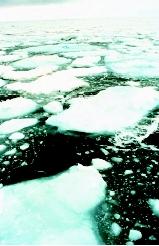Sea Water, Freezing of
The density of ocean water is determined by its salinity (or salt content) and temperature. The saltier and/or colder the water is, the denser it is. Salt water is most dense at its freezing point, unlike fresh water, which is most dense at about 3.9°C (39.0°F). Oceans are highly stratified: deep ocean water is heavy, and the lighter water is on top. This often is not the case in the atmosphere: warm air near the ground surface is lighter than the overlying air it displaces, resulting in unstable conditions and thunderstorms.
The stratified, stable nature of oceans is important because otherwise there would be no sea ice , nor would there be warm tropical seas. Tropical oceans are temperature-stratified: a thermocline separates the warm, light water on top from the frigid deep waters. Polar oceans, on the other hand, are salinity-stratified: the salinity is slightly lower on top, especially in the Arctic and near the estuaries of large rivers such as the MacKenzie in Canada and the Ob in Russia. This fresh-water outflow will stay on top of the Arctic Ocean and mix only very slowly, because it is lighter. Instead of a thermocline, there is a halocline, a layer in which the salinity changes rapidly with depth. *
Salty water freezes below 0°C (32°F): this is why salt is used to melt the snow or ice on a road pavement. The saltier the brine , the lower its freezing point. This is also why salt traditionally was added to the water–ice mixture used to make ice cream.
Ocean water with a typical salinity of 35 parts per thousand freezes only at −1.8°C (28.9°F). So if there were no halocline in the polar oceans, then the cooled top ocean layer, being denser, would sink into the deep ocean, in the same way as thunderstorm clouds rise in the atmosphere, and the entire ocean column would have to cool to −1.8°C before its surface could freeze.
Formation of Sea Ice
As sea water freezes, salt is excluded, because salt has a different crystalline structure: it forms cubic crystals (with four sides) whereas ice is hexagonal, or six-sided. (A close look at tiny snowflakes will reveal their hexagonal form.) So pockets of brine form within the ice; they refuse to freeze, because of the high salinity. The brine then slowly leaches out of the bottom of the forming ice and drips into the ocean below. Thus sea ice, when melted, is considerably fresher than the original sea water from which it formed. This brine rejection process creates dense water below the ice surface. This layer of dense water may sink to the bottom of the ocean. Furthermore, this

The salt enrichment is most effective when it occurs in a thin layer on a calm sea. The faster sea ice is frozen, the less salt that can escape. For instance, when frozen at an air temperature of −40°C (−40°F), the salinity of the ice is about 10 percent. But when frozen at an air temperature of −6°C (21°F), the salinity of the ice is only about 4 percent. Such ice is fresh enough to use as drinking water; in fact, in spring, polar bears often drink the water in melting ponds on ice.
When sea ice melts in the summer, the meltwater forms a relatively fresh surface layer that lies above the saltier ocean water, maintaining the halocline, and allowing easier freezing the next winter.
SEE ALSO Brines, Natural ; Ice at Sea ; Ocean Chemical Processes ; Sea Water, Physics and Chemistry of.
Bart Geerts
Bibliography
Thurman, Harold V. Essentials of Oceanography. Upper Saddle River, NJ: PrenticeHall, 1999.
* See "Sea Water, Physics and Chemistry of" for a diagram illustrating a thermocline and a halocline.
"For instance, when frozen at an air temperature of −40°C (−40°F), the salinity of the ice is about 10 percent. But when frozen at an air temperature of −6°C (21°F), the salinity of the ice is only about 4 percent."
"10 percent" should read 10 parts per thousand.
"4 percent" should read 4 parts per thousand.
(note that seawater salinity is only about 3.5 percent)
Best regards. I hope you can answear that. :)